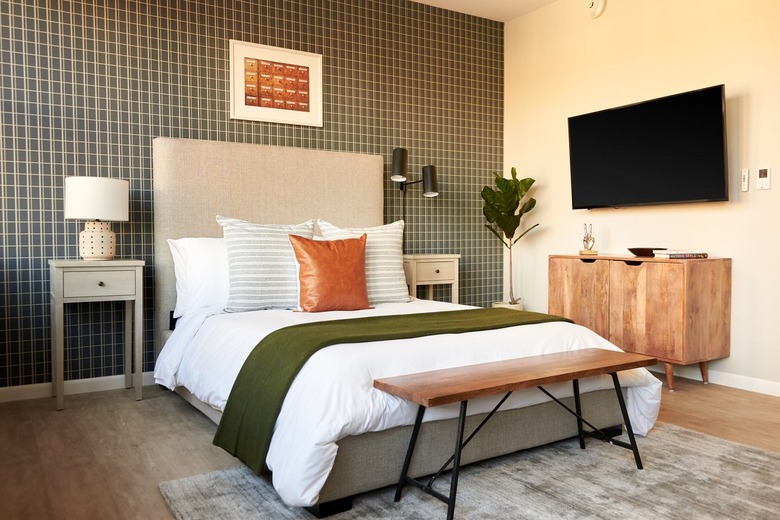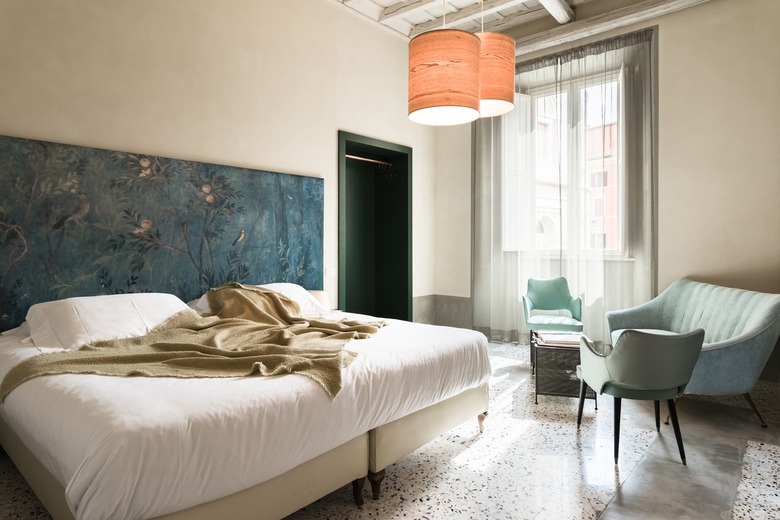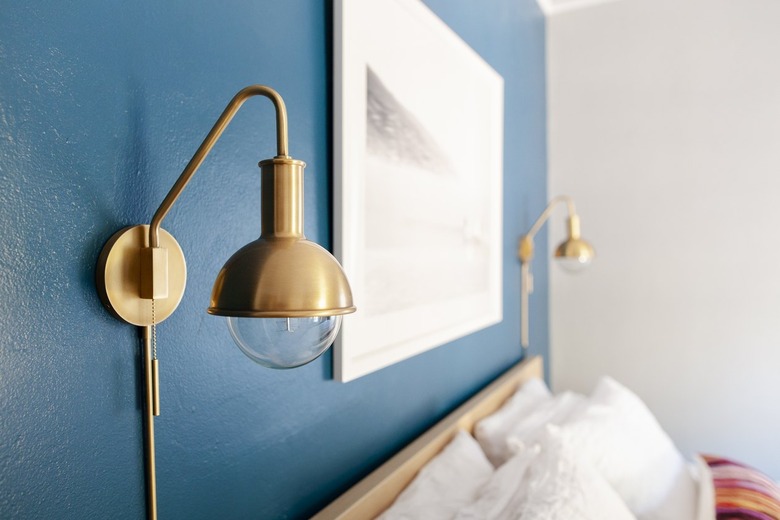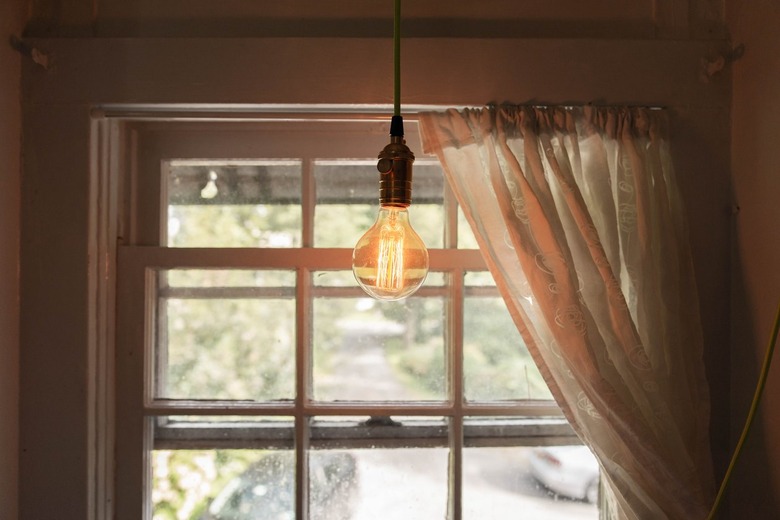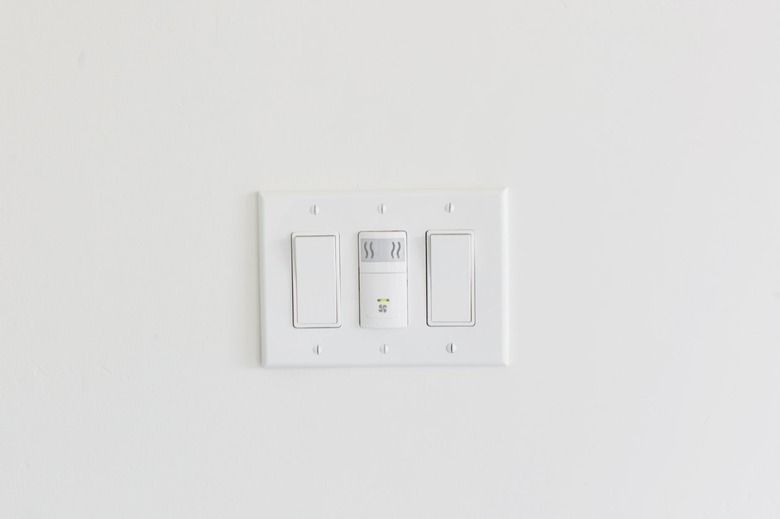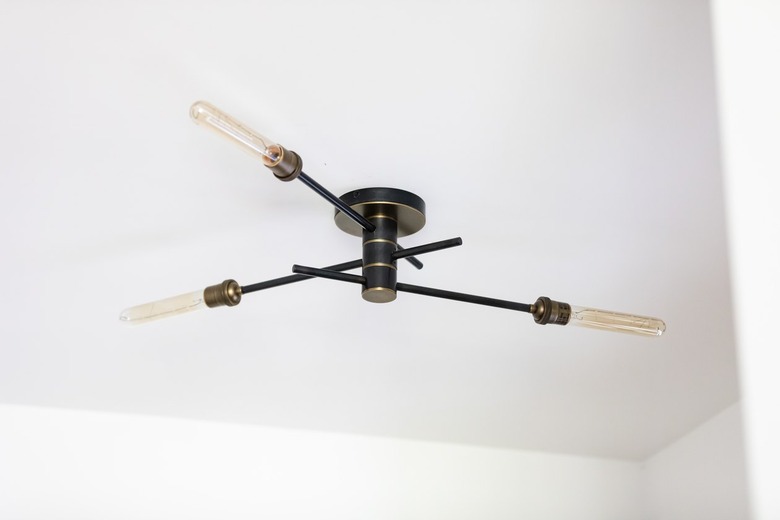Bedroom Lighting Design: How To Best Illuminate Your Space
We may receive a commission on purchases made from links.
With the right bedroom lighting design, the space can be much more than just a place to crash. Use lighting to create a bedroom where you can relax, revitalize, and rejuvenate — whether that means resting with a good book before bed or getting dressed in a space where you can easily tell the difference between black and navy blue socks. Whatever you ask of your bedroom, the right lighting can help it deliver.
Layer Lighting
Layer Lighting
Because you use your bedroom for multiple activities, you need multiple types of lighting:
- Ambient lighting
- Task lighting
- Accent lighting
Ambient lighting is the general lighting that illuminates the space, often in the form of natural light via windows during the day and otherwise from artificial light (which may or may not be overhead lighting). Ambient lighting is the basic light that allows you to function in the space when performing general tasks, like putting away the laundry or changing the bed sheets.
Task lighting is focused illumination that helps you accomplish a specific goal. If you get dressed in your bedroom, you'll want spotlights or other forms of task lighting that can help you see into your closet easily and pick out the pieces you want to wear. You may also need task lighting at the vanity where you put on your makeup. And if you read in bed, you'll need bedside lighting that can make it easy to see without producing glare on the page or disturbing your partner.
Accent lighting is not strictly necessary, but you may feel something is missing without it. In any room, accent lighting is used to highlight artwork or other areas of the room you want to showcase. In a bedroom, accent lighting is largely about ambiance. It can create a more intimate feeling and add a sense of warmth.
Tip
If you're lighting on a budget or working in a small space, you can shortcut accent lighting by adding dimmer switches to ambient lighting fixtures. This will allow you to brighten or dim the light as the occasion warrants, easily going from bright lights to a more intimate mood without extra lighting fixtures.
Consider Your Space
Consider Your Space
You'll find tons of great bedroom lighting ideas at the home improvement store, online, and in design magazines. But before you get too carried away, consider the space you're working with. Floor lamps and table lamps, for example, can work beautifully as task and accent lighting, but only if you have adequate outlets for plugging them all in. Bedside lamps require bedside tables. If your room is small, pendant lights hanging over a petite bedside table may better suit your space. Wall sconces beside your headboard may also be an option.
In places where you need lots of light but don't have lots of space, consider small fixtures, like LED strip lights, recessed lighting, or puck lights. These work well in and around closets and wardrobes. When working with a small space, it's also a good idea to choose light fixtures that can do double duty. A wall sconce next to your mirror, for instance, can light up your space when you get ready in the morning and add ambient light by reflecting light off the wall behind it.
Basics of Brightness
Basics of Brightness
Even when choosing ambient lighting, you don't necessarily want the brightest light bulb you can get. While brightness was formerly thought of in terms of wattage, the prevalence of LED and CFL bulbs now has people thinking about light bulb brightness in the more proper term of lumens. If you need a point of reference to help you visualize this, note that a 40-watt incandescent bulb provides about 400 lumens of light, while a 60-watt bulb emits 700 lumens. By comparison, an LED bulb rated at 400 lumens actually uses about 9 watts of electricity. Lumens ratings are noted on the bulb packaging.
Generally, you want your bedroom's total lighting to fall between 2,000 and 4,000 lumens. The smaller the space, the lower you can go. Overall, you want 10 to 20 lumens per square foot, but how you distribute those lumens matters.
Usually, you want about 100 lumens for reading, 380 lumens in your closet, and 1,690 lumens where you get dressed and groomed. Here again, a dimmer can come to the rescue. If you have limited space or lighting options, a dimmer can help your lighting fixtures multitask by adding or subtracting lumens as needed.
Remember too that lampshades impact brightness. Although it may set a mood and match your decor, a dark shade on a bedside table lamp will dim the light and can make reading difficult. A lighter shade will keep things brighter while still preventing glare.
The Color of Lighting
The Color of Lighting
When shopping for bedroom lighting and bulbs, you'll find many different colors, or tones, of lighting. This is known in the lighting industry as color temperature. As is true of brightness, the colors you want depend on both personal preference and the purpose of the light. Blue, or cool, light tends to make people more alert and limits the body's production of melatonin, so it's generally best avoided as bedroom lighting. One exception is when part of your bedroom is used as a workspace or office. In that case, task-style fixtures with cool lighting in your work area might work best, but avoid placing blue bulbs elsewhere in the room.
Warmer yellow lights don't tend to interfere with melatonin production. Yellow lights are good for activities like watching television and reading. They're also more relaxing, making them a good choice for bedroom light fixtures.
Tip
Color temperature is measured in degrees Kelvin (K). The higher the K number, the cooler and brighter the light. Warm white light is 2,000K to 3,000K. Cool white or "bright white" light is 3,100K to 4,500K. Higher than 4,500K is considered "daylight."
Keep Switches Convenient
Keep Switches Convenient
Part of getting your bedroom lighting right is keeping it convenient. Sometimes, there is just no getting around the need to get up to go to the bathroom just as you get comfortable. But at the very least, you can make sure you never have to get up to turn out the light. One way to accomplish this is to install a light switch next to your bed. Even if you use a bedside lamp or wall sconces, an extra switch will allow you to control your overhead lighting from the comfort of your bed..
Although sleep experts tell us we probably shouldn't, many of us are guilty of bringing our smartphones to bed with us. If you do, consider a dimmer switch that you can adjust and turn off using a smartphone app. You can also opt for lights with Wi-Fi that are compatible with Alexa and other similar devices, allowing you to control your bedroom lighting with your voice or phone. These serve as a kind of modern-day Clapper light that lets you control the brightness of the light rather than just turning the lights off or on.
When considering where to add light switches, remember that convenience may not be the sole factor. There are some standards to which you should adhere, such as placing light switches inside the door about 4 feet off the floor. This is where they usually are and is where people naturally look for them when reaching into a dark room. If you're modifying the room for ADA compliance, switches may need lowering.
Tip
Building codes may limit where you can add light switches and controls. Adding a lamp or switching out an existing light fixture generally doesn't require a permit or inspection. If you're moving a light switch, adding new switches, or installing wall-mounted and ceiling-mounted lights in a new location, there is a good chance you might need to apply for a permit from your local authorities.
Give Yourself Creative Options
Give Yourself Creative Options
From homework and play dates to sleepy cuddles and Sunday morning breakfast in bed, bedrooms can host a wide variety of activities. Therefore, you may want to allow for several different lighting options in your space.
One way to do so is with LED bulbs that offer a wide variety of color options. Sure, you can change these bulbs from a warm yellowish light to a blue or white task light when you need to, but you can also think bigger. You can get LED light bulbs that come with a remote control and offer 16 different light colors or more. These can make a great addition to a kid's room, of course, but they can also add fun mood lighting for a change of scenery in any bedroom.
It's okay to have a little fun with your bedroom lighting as well. If, for example, you love the ambiance of chandeliers or fairy light strands, find creative ways to add them to the room. When looking for bedroom lighting ideas and tips, it's easy to get caught up in interior design trends and technical specifications from the experts. While these things are important, remember that your bedroom is your own, and we encourage you to add a bit of whimsy or a lighting feature that brings you joy.
